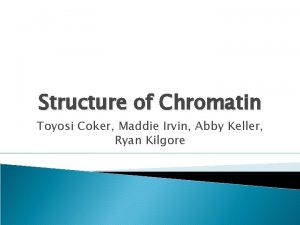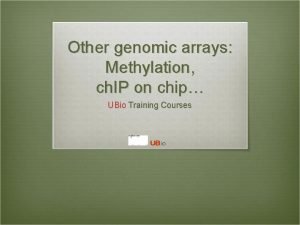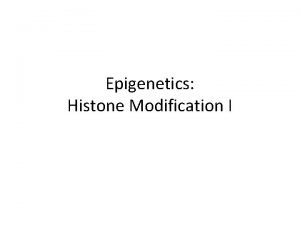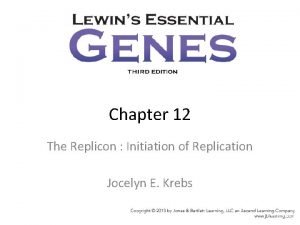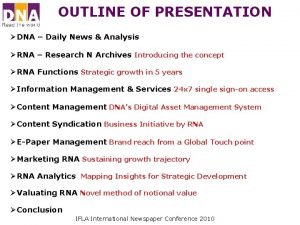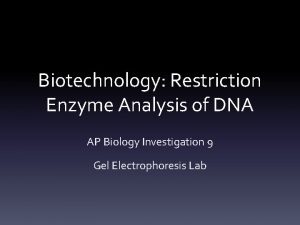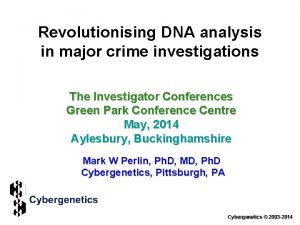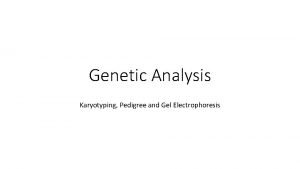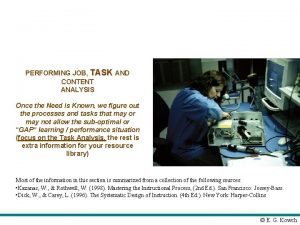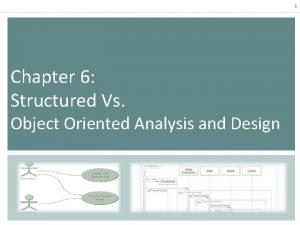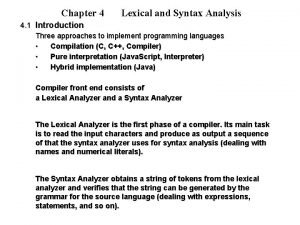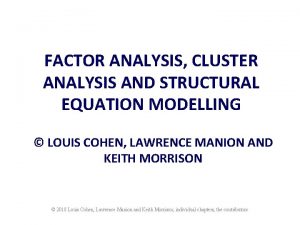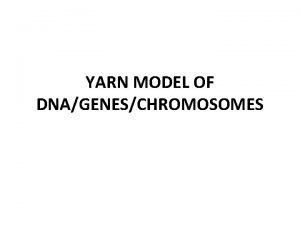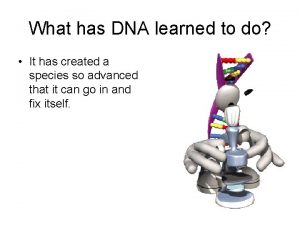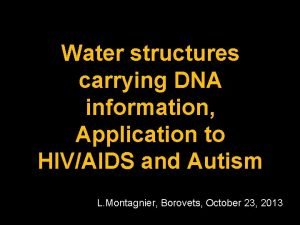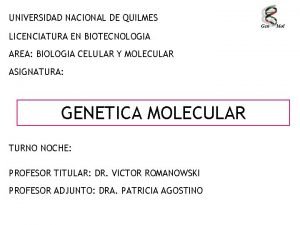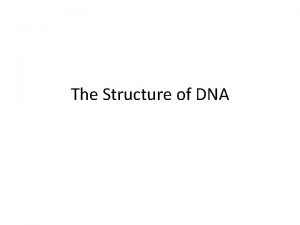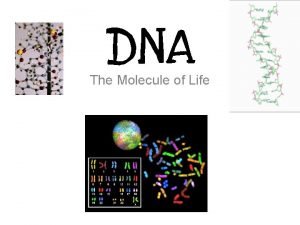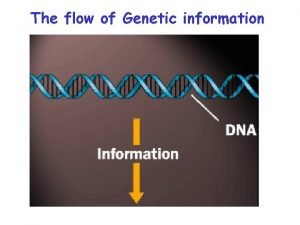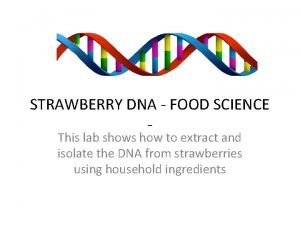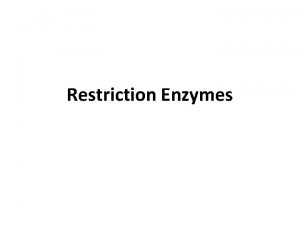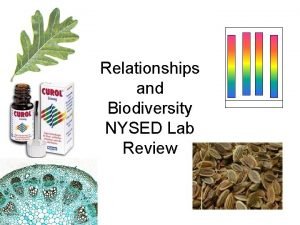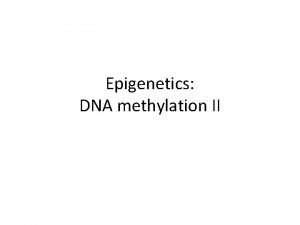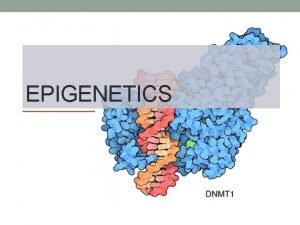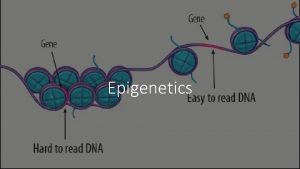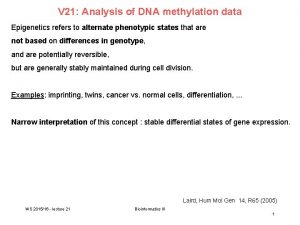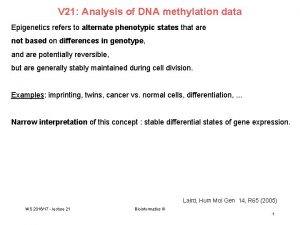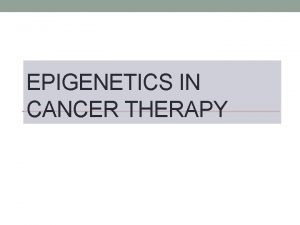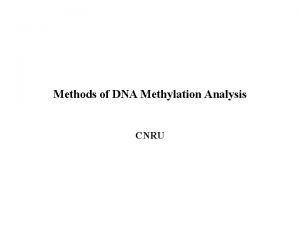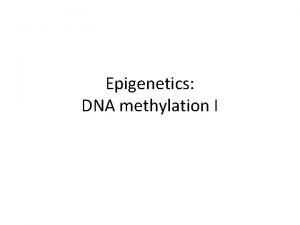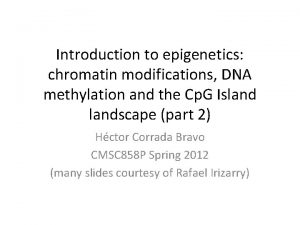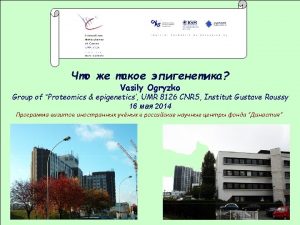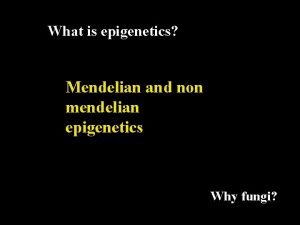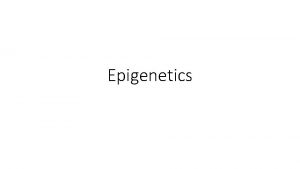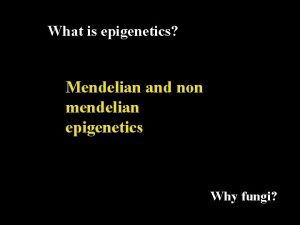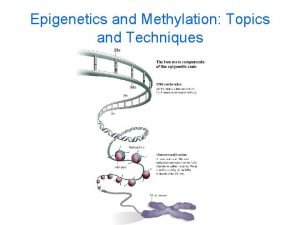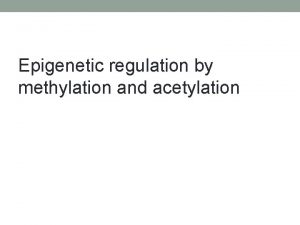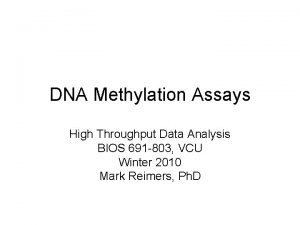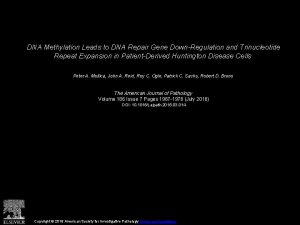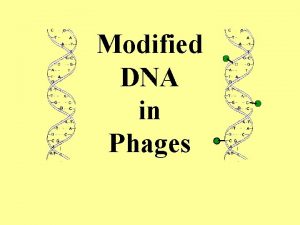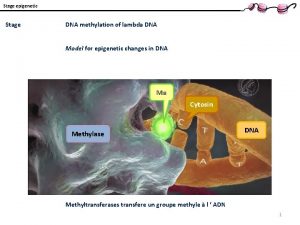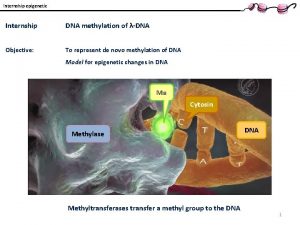V 15 Analysis of DNA methylation data Epigenetics














































- Slides: 46

V 15: Analysis of DNA methylation data Epigenetics refers to alternate phenotypic states that are not based on differences in genotype. They are potentially reversible, but are generally stably maintained during cell division. Examples: - imprinting (monoallelic expression – one allele silenced by DNA methylation), - cell differentiation, - cancer vs. normal cells, …. - repetitive genomic sequences such as human endogenous retroviral sequences (HERVs) are heavily methylated, which means transcriptionally silenced. Laird, Hum Mol Gen 14, R 65 (2005) WS 2019/20 - lecture 15 Bioinformatics III 1

11. 1 What is epigenetics? Epigenetics is nowadays considered to invovle multiple mechanisms that interact to collectively establish: - alternate states of chromatin structure (open – packed/condensed), - histone modifications, - composition of associated proteins (e. g. histones), - transcriptional activity, - activity of micro. RNAs, - in mammals, cytosine-5 DNA methylation at Cp. G dinucleotides, - in bacteria adenine-6 DNA methylation. Laird, Hum Mol Gen 14, R 65 (2005) WS 2019/20 - lecture 15 Bioinformatics III 2

11. 1 Epigenetic marks around the NANOG gene after 2 days of directed differentiation of human embryonic stem cells into mesoderm tissue. Top row : DNA methylation level. Next six rows : presence/absence of specified histone marks. Bottom row : level of gene transcription measured by RNA sequencing. Shown at the bottom is the exon structure of the gene NANOG that is crucial for development. WS 2019/20 - lecture 15 Gifford CA et al. (2013) Cell 153, 1149 -1163 Bioinformatics III 3

Waddington epigenetic landscape for embryology Waddington worked in embryology a) is a painting by John Piper that was used as the frontispiece for Waddington's book Organisers and Genes. It represents an epigenetic landscape. Developmental pathways that could be taken by each cell of the embryo are metaphorically represented by the path taken by water as it flows down the valleys. Slack, Nature Rev Genet 3, 889 -895 (2002) WS 2019/20 - lecture 15 Conrad Hal Waddington (1905 – 1975) pictures. royalsociety. org b) Later depiction of the epigenetic landscape. The ball represents a cell, and the bifurcating system of valleys represents bundles of trajectories in state space. Bioinformatics III 4

Cytosine methylation Observation: 3 -6 % of all cytosines are methylated in human DNA. This methylation occurs (almost) exclusively when cytosine is followed by a guanine base -> Cp. G dinucleotide. 5 -methyl-cytosine SAM: S-adenosyl-methionine SAH: S-adenosyl-homocysteine Cytosine As most Cp. Gs serve as targets of DNA methyltransferases, about 70 - 80% of them are usually methylated. BUT mammalian genomes contain much fewer (only 20 -25 %) of the Cp. G dinucleotide than is expected by the G+C content (we expect 1/16 ≈ 6% for any random dinucleotide). This is typically explained in the following way: …. (see following page) WS 2019/20 - lecture 15 Esteller, Nat. Rev. Gen. 8, 286 (2007) www. wikipedia. org Bioinformatics III 5

Cytosine methylation 5 -Methylcytosine can easily deaminate to thymine. 5 -methyl-cytosine thymine If this mutation is not repaired, the affected Cp. G is permanently converted to Tp. G (or Cp. A if the transition occurs on the reverse DNA strand). Hence, methyl. Cp. Gs represent mutational hot spots in the genome. If such mutations occur in the germ line, they become heritable. A constant loss of Cp. Gs over thousands of generations can explain the low frequency of this special dinucleotide in the genomes of human and mouse. WS 2019/20 - lecture 15 Bioinformatics III Esteller, Nat. Rev. Gen. 8, 286 (2007) www. wikipedia. org 6

chromatin organization affects gene expression Schematic of the reversible changes in chromatin organization that influence gene expression: genes are expressed (switched on) when the chromatin is open (active), and they are inactivated (switched off) when the chromatin is condensed (silent). White circles = unmethylated cytosines; red circles = methylated cytosines. WS 2019/20 - lecture 15 Rodenhiser, Mann, CMAJ 174, 341 (2006) Bioinformatics III 7

DNA fiber forms A-DNA B-DNA Z-DNA Requires more methylation, higher concentration of physiological salts Methylation of adenine vs. cytosine has very different effects Dry Environment WS 2019/20 - lecture 15 Most prominent in cellular conditions Bioinformatics III Equilibrium shift with specific conditions

Protein-DNAMe interaction (R. Dpn. I from E. coli) Left: structural transitions of DNA affect accessibility of the base pairs Right: recognition of 6 -methylated adenine (common form of DNA methylation in bacteria) Siwek et al. Nucl. Acids Res. (2012) 40 (15): 7563 -7572. WS 2019/20 - lecture 15 Bioinformatics III 9

Protein-DNAMe interaction Binding of E. coli restriction enzyme R. Dpn. I to adenine-methylated or unmethylated target sequence. R. Dpn. I has 2 domains that bind DNA, a „catalytic“ domain and a „winged“ domain. -> methylation linked to increased width of major groove when bound to „catalytic“ domain, not to „winged“ domain. Solid lines: free DNA WS 2019/20 - lecture 15 Binding of Me. CP 2 to cytosinemethylated or unmethylated target BDNF sequence from human -> methylation has smaller effects on width of major groove Bioinformatics III Ph. D thesis Siba Shanak (2015) 10

Enzymes that control DNA methylation and histone modfications The dynamic chromatin states are controlled by reversible epigenetic patterns of DNA methylation and histone modifications. Enzymes involved in these processes include - DNA methyltransferases (DNMTs), - histone deacetylases (HDACs), - „writers“ such as histone acetylases and histone methyltransferases and - „reader“ proteins such as the methyl-binding domain protein MECP 2. Rodenhiser, Mann, CMAJ 174, 341 (2006) Feinberg AP & Tycko P (2004) Nature Reviews: 143 -153 WS 2019/20 - lecture 15 Bioinformatics III 11

DNA methylation Typically, unmethylated clusters of Cp. G pairs are located in tissue-specific genes and in essential housekeeping genes. (House-keeping genes are involved in routine maintenance roles and are expressed in most tissues. ) These clusters, or Cp. G islands, are targets for proteins that bind to unmethylated Cp. Gs and initiate gene transcription. In contrast, methylated Cp. Gs are generally associated with silent DNA, can block methylation-sensitive proteins and can be easily mutated. The loss of normal DNA methylation patterns is the best understood epigenetic cause of disease. In animal experiments, the removal of genes that encode DNMTs is lethal; in humans, overexpression of these enzymes has been linked to a variety of cancers. Rodenhiser, Mann, CMAJ 174, 341 (2006) WS 2019/20 - lecture 15 Bioinformatics III 12

Cp. G islands are characterized by an elevated density of Cp. G dinucleotides that can be targeted by DNA methylation (elevated relative to the rest of the genome). Cp. G islands are regulatory elements and are often located in the promoter region of genes. Criteria to define Cp. G islands: Gardiner-Garden and Frommer: ≥ 200 bp length, G + C ≥ 50% Cp. Gobs/Cp. Gexp ≥ 0. 6 Takai and Jones: ≥ 500 bp length G + C ≥ 55% Cp. Gobs/Cp. Gexp ≥ 0. 65. Hutter, Helms, Paulsen, Genomics 88, 323 (2006) WS 2019/20 - lecture 15 Bioinformatics III 13

Cp. G islands Average total length of Cp. G islands per gene in repeat-masked sequences at five different locations in (A) Mouse, (B) human. Imprinted genes are monoallelically expressed, the other allele is silenced by DNA methylation. In 2006, about 100 imprinted genes were experimentally confirmed. Ctrl 1, ctrl 2: groups of randomly selected (most likely biallelic) control genes Takai and Jones parameters -> Cp. G islands frequent in promoters and in the gene body of imprinted genes. Hutter, Helms, Paulsen, Genomics 88, 323 (2006) WS 2019/20 - lecture 15 Bioinformatics III 14

Differentiation linked to alterations of chromatin structure (B) Upon differentiation, inactive genomic regions may be sequestered by repressive chromatin enriched for characteristic histone modifications. (A) In pluripotent cells, chromatin is hyperdynamic and globally accessible. ML Suva et al. Science 2013; 339: 1567 -1570 WS 2019/20 - lecture 15 Bioinformatics III 15

Altered DNA methylation upon cancerogenesis Esteller, Nat. Rev. Gen. 8, 286 (2007) WS 2019/20 - lecture 15 Bioinformatics III 16

DNA methylation is typically only weakly correlated with gene expression! Left: different states of hematopoiesis (blood cell differentiation). HSC: hematopoietic stem cell MPP 1/2: multipotent progenitor cell Right: skin cell differentiation WS 2019/20 - lecture 15 Bock et al. , Mol. Cell. 47, 633 (2012) Bioinformatics III 17

Promoter methylation vs. gene-body methylation The relationship between methylation and gene expression is complex. High levels of gene expression are often associated with low promoter methylation but elevated gene body methylation. However, the causality relationships between expression levels and DNA methylation have not yet been completely determined. Wagner et al. Genome Biology (2014) 15: R 37 http: //methhc. mbc. nctu. edu. tw WS 2019/20 - lecture 15 Bioinformatics III 18

Detect DNA methylation by bisulfite conversion Or NGS sequencing WS 2019/20 - lecture 15 Bioinformatics III www. wikipedia. org 19

Processing of DNA methylation data with Rn. Beads Left stages: processing of raw data (sequencing reads e. g. from bisulfite conversion) Assenov et al. Nature Methods 11, 1138– 1140 (2014) WS 2019/20 - lecture 15 Bioinformatics III 20

DNA methylation analysis with Rn. Beads Top: read coverage of Cp. Gs Bottom: „Volcano“ plot x-axis – difference of methylation site between 2 probes, y-axis – statistical significance of the difference; Distribution of beta-values Assenov et al. Nature Methods 11, 1138– 1140 (2014) WS 2019/20 - lecture 15 Bioinformatics III Require enough variation and enough significance 21

Beta-values measure fractional DNA methylation levels After analysis of raw sequencing data + filtering of problematic regions etc the degree of methylation is typically expressed as fractional beta value: %m. CG(i) / ( %m. CG(i) + %CG(i) ) A beta value for Cp. G position i takes on values between 0 (position i not methylated) and 1 (position i fully methylated) WS 2019/20 - lecture 15 Bioinformatics III 22

Methylation levels of neighboring sites are correlated - Observation: methylation levels of neighboring Cp. G positions within 1000 bp are often correlated; - distance between neighboring Cp. Gs is ca. 100 bp (1% frequency) - Idea: exploit this effect to „smoothen“ experimental data, e. g. when this is obtained at low coverage Master thesis of Junfang Chen (February 2014): WS 2019/20 - lecture 15 Bioinformatics III 23

Correlated methylation of neighboring Cp. Gs t : target Cp. G site h : „band-width“: size of window (# of neighboring Cp. Gs around t) yi : methylation level of i-th Cp. G site within window of given size Ct(i): weighting factor to consider read coverage of neighboring Cp. G sites relative to that of target site Kh(t, i): Kernel function that considers the distance between positions t and i. -> more distant positions get smaller weight. WS 2019/20 - lecture 15 Bioinformatics III 24

Choice of kernel function The kernel K www. wikipedia. org WS 2019/20 - lecture 15 Bioinformatics III 25

Correlation of low-coverage and high-coverage data C 1, C 2, C 3 are three different samples. Best results for window considering nearby 10 -20 Cp. Gs. Gaussian kernel Epanechikov kernel Tricubic kernel Gaussian kernel („hg“) more robust with distance (exponential weighting). Tricubic and Epanechikov kernels show stronge decrease for large windows. Every method was tested for including neighboring 5, 10, 15, … 70 Cp. Gs. Red symbols „hl“ : low-coverage data (unsmoothened) Brown symbols „hb“: low-coverage data processed with (another) Bsmooth-program WS 2019/20 - lecture 15 Bioinformatics III 26

DNA methylation in breast cancer Infinium Human. Methylation 27, Rev. B Bead. Chip Kits WS 2019/20 - lecture 15 Bioinformatics III 27

DNA methylation in cancer Normal cell Cancer cell WS 2019/20 - lecture 15 Cp. G Islands Bioinformatics III 28

The Cancer Genome Atlas WS 2019/20 - lecture 15 Bioinformatics III 29

The Cancer Genome Atlas WS 2019/20 - lecture 15 Bioinformatics III 30

11. 2 Differential methylation analysis After quantification of methylation levels, one typically detects differentially methylated regions (DMRs) that show consistent differences between sample groups (e. g. cases versus controls). Length of DMRs ranges from a single cytosine base to an entire gene locus. In some cases a single methylated Cp. G may be involved in regulating gene expression and may thus affect disease risk. The vast majority of known DMRs have a size between a few hundred and a few thousand bases. This range matches that of gene-regulatory regions. It is assumed that DMRs can regulate transcriptional repression of an associated gene in a cell-type-specific manner. WS 2019/20 - lecture 15 Bioinformatics III 31

11. 2 Differential methylation analysis Given sufficient data for 2 groups of samples, DMRs can be detected by t-tests or Wilcoxon rank-sum tests (see differential expression analysis, V 10). Importantly, when differences in DNA methylation are detected by a statistical test at a large number of genomic loci, the results need to be corrected for multiple hypothesis testing so that a false-discovery rate is inferred for each DMR. As there exists a large number of Cp. Gs in the genome, often only the most pronounced single-Cp. G differences are kept as significant after such an adjustment. WS 2019/20 - lecture 15 Bioinformatics III 32

11. 2 Differential methylation analysis One can apply 2 complementary strategies to enhance the statistical power while detecting weak differences in DNA methylation. (1) one can apply the statistical tests to longer genomic regions rather than to individual Cp. G sites. (Reason: there are much fewer of them. Not so much statistical power is lost due to multiple testing correction. ) If neighbouring Cp. Gs show similar differences of DNA methylation levels, this reduced „resolution“ leads to more significant results. (2) small standard deviations frequently arise by chance and may yield spurious results. When the standard deviation of a given Cp. G or genomic region is estimated by taking the average of observed and expected values, more robust pvalues can be obtained for DNA methylation comparisons with many measurements and few samples per sample group. WS 2019/20 - lecture 15 Bioinformatics III 33

Idea: identify co-methylation of genes in TCGA samples Co-methylation of genes 1 and 3 across samples WS 2019/20 - lecture 15 Bioinformatics III 34

Tumor data Data Type (Base. Specific) DNA Methylation • • • Level 1 (Raw Data) Level 2 (Normalized/ Processed) Level 3 (Segmented/ Interpreted) Raw signals Normalized Methylated per probe signals per sites/genes probe or per sample probe set and allele calls Level 4 (Summary Finding/ROI) Statistically significant methylated sites/genes across samples 183 tumor samples deposited in Sept 2011 (tumor group 1); 134 tumor samples deposited in Oct 2011 (tumor group 2) and 27 matched normal samples from Oct 2011. WS 2019/20 - lecture 15 Bioinformatics III 35

ZNF 143 Difficulties: batch effect 0. 35 0. 3 0. 25 0. 2 0. 15 0. 1 0. 05 0 tumor group 1 Sept. 2011 tumor group 2 Oct. 2011 norm 0 0. 2 0. 4 DLGAP 5 0. 6 Filter 1: delete genes affected by batch effect WS 2019/20 - lecture 15 Bioinformatics III 36

CLK 1 Difficulties: outliers 0. 8 0. 7 0. 6 0. 5 0. 4 0. 3 0. 2 0. 1 0 tumor group 1 tumor group 2 norm 0 0. 5 YIPF 5 1 Filter 2: require zero outliers WS 2019/20 - lecture 15 Bioinformatics III 37

Difficulties: low variance 0. 25 LEMD 3 0. 2 0. 15 tumor group 1 tumor group 2 norm 0. 1 0. 05 0 0 0. 05 0. 15 C 1 R 0. 2 Filter 3: delete genes with low variance WS 2019/20 - lecture 15 Bioinformatics III 38

Comparison against randomized data We found a significantly larger number of co-methylated gene pairs (r > 0. 75) than expected by chance. WS 2019/20 - lecture 15 Bioinformatics III 39

Known breast cancer genes in OMIM: mostly unmethylated These 19 genes are associated with breast cancer in the Online version of the Mendelian Inheritance in Man (OMIM) database. They are not involved in co-methylation because most of them show little changes of their (low) methylation levels WS 2019/20 - lecture 15 Bioinformatics III 40

top 10 co-methylated gene pairs Second First gene Pearson correlation Related genes? SPRR 1 B SPRR 1 A 0, 872 Yes FCN 2 FCN 1 0, 870 Yes CD 244 CD 48 0, 866 Yes SPRR 1 B SPRR 4 0, 862 Yes TAS 2 R 13 PRB 4 0, 859 No F 7 TFF 1 0, 856 No SH 3 TC 2 SPARCL 1 0, 853 No ABCE 1 SC 4 MOL 0, 849 No REG 1 B REG 1 P 0, 846 Yes SPRR 3 SPRR 4 0, 843 Yes Some genes have related names -> co-methylation may be expected WS 2019/20 - lecture 15 Bioinformatics III 41

Are all co-methylated genes neighbors? Less than half of all co-methylated gene pairs lie on the same chromosome co-methylation level 0. 93 0. 88 Functional similarity of gene pairs (see V 11) 0. 83 bp_simrel or mf_simrel>=0. 5 bp_simrel and mf_simrel<0. 5 0. 78 0. 73 0. 68 1. 00 E+02 1. 00 E+04 1. 00 E+06 1. 00 E+08 genomic distance 4 1 102 10 106 108 bp: biological process (GO) mf: molecular function (MF) Distance between genes (bps) WS 2019/20 - lecture 15 Bioinformatics III 42

Functional similarity of co-methylated genes Co-methylated gene pairs on the same chromosome have higher functional similarity (determined by Fun. Sim. Mat) than between random pairs of genes Not the case for co-methylated gene pairs on different chromosomes WS 2019/20 - lecture 15 Bioinformatics III 43

Enriched pathways in co-methylated gene clusters WS 2019/20 - lecture 15 Bioinformatics III 44

Further modifications of cytosine bases Further modifications were discovered in the last few years. They are present in cells in much smaller fractions than 5 -m. C. Tet enzymes catalyze the conversions. The biological roles of these modifications are mostly unclear. http: //he-group. uchicago. edu WS 2019/20 - lecture 15 Bioinformatics III 45

Summary DNA methylation and histone marks are epigenetic modifications of genomic DNA and nucleosomes that appear to have regulatory roles in a broad range of biological processes and diseases. Detection of DMRs allows to distinguish and classify different developmental stages of cell differentiation or to distinguish tumor tissue from normal tissue. DNA methylation levels are generally higher in condensed chromatin regions and in differentiated cells than in open chromatin regions and in stem cells. Our understanding of the relationship between epigenetic modifications and their effects on gene expression levels is still limited. DNA methylation levels of promoter regions only show weak anticorrelation of around 0. 15 with the expression levels of the respective genes. WS 2019/20 - lecture 15 Bioinformatics III 46
 Methylation vs acetylation
Methylation vs acetylation Methylation & chip-on-chip microarray platform
Methylation & chip-on-chip microarray platform Herzig meyer method
Herzig meyer method Histone modification epigenetics
Histone modification epigenetics What is epigenetics
What is epigenetics Adenine methylation
Adenine methylation Replication fork
Replication fork Bioflix activity dna replication lagging strand synthesis
Bioflix activity dna replication lagging strand synthesis Coding dna and non coding dna
Coding dna and non coding dna Replication process
Replication process Chapter 11 dna and genes
Chapter 11 dna and genes Dna daily news and analysis
Dna daily news and analysis Restriction enzyme analysis of dna ap bio lab
Restriction enzyme analysis of dna ap bio lab Dna analysis
Dna analysis Restriction ends
Restriction ends Content analysis of secondary data
Content analysis of secondary data Data collection procedure
Data collection procedure Data preparation and basic data analysis
Data preparation and basic data analysis Data acquisition and data analysis
Data acquisition and data analysis Structured tools
Structured tools Cuckoo sandbox online
Cuckoo sandbox online Discourse and content analysis
Discourse and content analysis Difference between contrastive analysis and error analysis
Difference between contrastive analysis and error analysis Contrastive analysis error analysis and interlanguage
Contrastive analysis error analysis and interlanguage Fact finding methods in system development
Fact finding methods in system development Content analysis and task analysis
Content analysis and task analysis Game analysis in transactional analysis
Game analysis in transactional analysis Ooad vs oop
Ooad vs oop Lexical and syntax analysis
Lexical and syntax analysis Technical feasibility example
Technical feasibility example Kmo test
Kmo test Dna model using yarn of different colors
Dna model using yarn of different colors Separating dna
Separating dna Application dna
Application dna Genghis khan dna map
Genghis khan dna map Ancestry dna sverige
Ancestry dna sverige Desnaturalizacion del dna
Desnaturalizacion del dna Dna structure and replication pogil
Dna structure and replication pogil Transcription and translation coloring
Transcription and translation coloring Dna strands are antiparallel. what does that mean
Dna strands are antiparallel. what does that mean Dna stand for
Dna stand for Dna replication is semi-conservative
Dna replication is semi-conservative Strawberry dna extraction materials
Strawberry dna extraction materials Dna itsepalvelu
Dna itsepalvelu Restriction enzymes
Restriction enzymes Dna transkripsi
Dna transkripsi Relationships and biodiversity lab
Relationships and biodiversity lab
